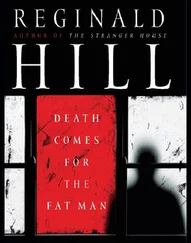“Let’s check the rest of the floor,” Meyer said.
There were two other apartments on the floor. The locks on the doors to both had been broken. In one apartment there were the remains of a recent fire in the center of the room. A worn tennis sneaker was in the corner near the window. Meyer lifted it with his handkerchief, and then bagged and tagged it for transportation to the lab. The second room was empty except for a soiled and torn mattress covered with rat leavings.
“What a shit hole,” someone said behind them, and Meyer and Carella turned to find Detective Monoghan in the doorway. Detective Monroe was immediately behind him. Both Homicide cops had gray fedoras on their heads, black topcoats on their backs, and pained expressions on their faces.
“People actually live in these shit holes, can you imagine that?” Monroe said.
“Incredible,” Monoghan said, wagging his head.
“Unbelievable,” Monroe said.
“Where’s the stiff?” Monoghan asked.
“Down the hall,” Carella said.
“Want to show me?”
“You’ll find it,” Carella answered.
“Come on,” Monoghan said to his partner, and both of them went down the hallway, big-shouldered men pushing their way through the empty corridor as though dispersing a crowd. “Holy mother of God!” Monoghan said.
Carella nodded.
There were footfalls on the steps. Two men in white picked their way over fallen plaster and lathe, looked up when they reached the landing, saw Carella, and walked to him immediately.
“Listen, are you in charge here?” one of them asked.
“It’s my case, yes,” Carella said.
“I’m Dr. Cortez, what’s this about wanting me to get somebody off the wall?”
“He’s got to be taken to the mortuary,” Carella said.
“Fine, we’ll get him to the mortuary. But your medical examiner says he’s nailed to the goddamn wall. I don’t...”
“That’s right.”
“ I don’t plan to take him down, pal.”
“Who do you suggest for the job, pal?” Carella asked.
“I don’t care who. You look strong enough, why don’t you handle it yourself?”
“That’s a murder victim in there,” Carella said flatly.
“That’s a corpse in there,” Cortez answered, equally flatly.
Monoghan was coming back down the corridor, holding his nose. Monroe was a step behind him, his hand cupped over the lower part of his face.
“These men are from Homicide,” Carella said. “Talk to them about it.”
“Who’s supposed to take down the corpse?” Cortez asked.
“The M.E. through with it?” Monoghan said.
“He won’t examine it here,” Carella said.
“He’s got to examine it here. Those are regulations. We can’t move the body till the M.E. examines it, pronounces it dead, and...”
“Yeah, go tell that to him ,” Cortez said.
“Where is he?” Monoghan asked.
“Downstairs. Puking out his guts.”
“Come on,” Monoghan said to his partner, and they headed for the staircase. “You wait here, Carella.”
They listened to the two Homicide cops making their way downstairs. Their footfalls died. There was a strained silence in the corridor.
“Listen, I’m sorry I got so snotty,” Cortez said.
“That’s okay,” Carella answered.
“But he knows the regulations as well as I do. He’s just trying to get out of a messy job, that’s all.”
“Um-huh,” Carella said.
“He knows the regulations,” Cortez repeated.
The assistant medical examiner, if he had not previously known the regulations, knew them letter-perfect by the time Monoghan and Monroe got through with him downstairs. With a handkerchief tied over his nose, and wearing rubber gloves, he took down the impaled body of the unidentified white male, and performed a cursory examination before declaring him officially dead.
Everybody could now begin tackling the next unpleasant task of finding out who had made him that way.
Detective Cotton Hawes looked at the photostat that came in Tuesday morning’s mail and decided it was General George Washington.
“Who does that look like to you?” he asked Miscolo, who had come out of the Clerical Office to pick up the weekend’s D.D. reports for filing.
“Napoleon Bonaparte,” Miscolo said dryly. Shaking his head, he went out of the squadroom muttering. Hawes still thought it looked like Washington.
He had been filled in on the latest activities of the Deaf Man, and he assumed now that the photostat was intended as a companion piece to the pictures of J. Edgar Hoover. He immediately connected Hoover and Washington in the obviously logical way — the main office of the Federal Bureau of Investigation was in the city of Washington, D.C. Hoover, Washington, simple. When dealing with the Deaf Man, however, nothing was simple; Hawes recoiled from his first thought as though bitten by it. If the Deaf Man’s planned crime was to take place in Washington, he would not be pestering the hard-working cops (Oh, how hard they worked!) of the 87th. Instead, he would be cavorting on the Mall, taunting the cops of the District of Columbia, those stalwarts. No. This picture of the father of the country was meant to indicate something more than the name of a city, Hawes was certain of that. He was equally certain that J. Edgar’s fine face was meant to represent something more than the name of a vacuum cleaner, splendid product though it was. He suddenly wondered what the “J.” stood for. James? Jack? Jerome? Jules?
“Alf!” he shouted, and Miscolo, down the corridor in the Clerical Office, yelled, “Yo?”
“Come in here a minute, will you?”
Hawes rose from behind his desk and held the picture of Washington out at arm’s length. Hawes was a big man, six feet two inches tall, weighing 190 pounds, give or take a few for sweets or pizza. He had a straight unbroken nose, a good mouth with a wide lower lip, and red hair streaked with white over the left temple, where he had once been knifed by a building superintendent who had mistaken him for a burglar. His eyes were blue, and his vision had been as sharp as a hatpin when he’d joined the force. But that was many years ago, and we all begin to show the signs of age, sonny. He held the picture at arm’s length now because he was a trifle far-sighted and not at all certain that Miscolo hadn’t identified it correctly.
No, it was Washington, all right, no question about it.
“It’s Washington,” he said to Miscolo as he came into the squadroom carrying a sheaf of papers.
“You don’t say?” Miscolo said dryly. He looked harried, and hardly in the mood for small talk. Hawes debated asking his question, figured What the hell, and plunged ahead regardless.
“What does the ‘J.’ in J. Edgar Hoover stand for?”
“John,” Miscolo said.
“Are you sure?”
“I’m positive.”
“John,” Hawes said.
“John,” Miscolo repeated.
The two men looked at each other.
“Is that all?” Miscolo asked.
“Yes, thanks a lot, Alf.”
“Don’t mention it,” Miscolo said. Shaking his head, he went out of the squadroom muttering.
John Edgar Hoover, Hawes thought. John. And George, of course. Names fascinated him. He himself had been named after the fiery Puritan preacher Cotton Mather. Hawes had never felt comfortable with the name and had debated changing it legally some ten years ago, when he was going with a Jewish girl named Rebecca Gold. The girl had said, “If you change your name, Cotton, I’ll never go out with you again.” Puzzled, he had asked, “But why, Rebecca?” and she had answered, “Your name’s the only thing I like about you.” He had stopped seeing her the next week.
Читать дальше












